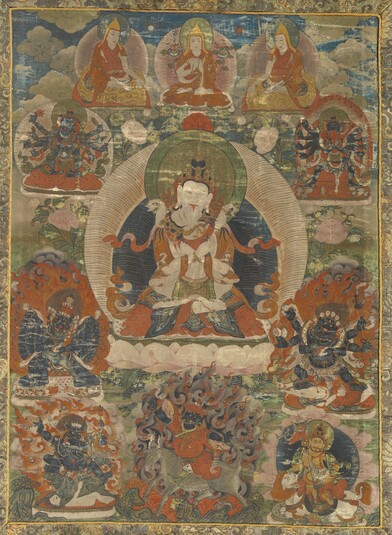
Item: Vajrasattva (Buddhist Deity) - White (with consort)
| Origin Location | China |
|---|---|
| Date Range | 1700 - 1799 |
| Lineages | Gelug and Buddhist |
| Size | 92x53cm (36.22x20.87in) |
| Material | Ground Mineral Pigment on Cotton |
| Collection | Royal Ontario Museum |
Classification: Deity
Appearance: Peaceful
Gender: Male
Vajrasattva with Consort, Heruka (Tibetan: dor je sem pa yab yum. English: Vajra Hero, Father-Mother): a Vajrayana meditational deity generally related to the process of Anuttarayoga initiation and empowerment rituals (wang kur, abhisheka) and a meditational deity specifically used for the purification of sins and defilements within the practice systems of major Tantric cycles such as Guhyasamaja, Hevajra and Chakrasamvara. (See Vajrasattva Main Page and the Vajrasattva Outline Page).
Sanskrit: Vajrasattva Tibetan: Dor je sem pa
Tibetan: Dor je sem pa
In the New (Sarma) Schools of Tibetan Buddhism Vajrasattva with consort arises from the class of Anuttarayoga Tantra. In the Chakrasamvara cycle of Tantras Vajrasattva is specifically taught in the Abhidhanottara Tantra, 25th chapter, and is known as Heruka Vajrasattva.
"...the bhagavan Vajrasattva Shri Heruka, with a body white in colour, one face, two hands holding a vajra and bell embracing the Mother. Adorned with six bone ornaments, seated with the legs in vajra posture, with the Lord of the Family as a crown - the same in appearance. In the lap is the Mother Vajragarvi, with a body white in colour, holding a curved knife and skullcup, adorned with five bone ornaments, in union." (Sakya liturgy).
The name of the female consort can vary between Tantra systems depending on the Tantra source literature and the specific description.
At the top center is Je Tsongkapa with Gyaltsab seated on the left and Khedrub seated on the right side.
Descending on the viewer's left side are the two meditational deities Akshobhyavajra Guhyasamaja and Vajrabhairava. Descending on the right is the meditational deity Chakrasamvara. Below that is Shadbhuja Mahakala with one face and six hands.
At the bottom center is the worldly protector Damchen Garwa Nagpo, the Blacksmith. On the left is Yama Dharmaraja and on the right Vaishravana Riding a Lion.
Depictions of Vajrasattva in sculpture and painting are commonly confused with the similar deities Vajradhara, Vajrapani, Vajravidarana, the Five Symbolic Buddhas in Sambhogakaya form, and others. In a number of Yoga Tantra examples the form of Vajrapani, in the Sarvadurgati Parishodhana Tantra system, appears exactly the same as the typical 'Solitary Hero' Vajrasattva. A sculpture of the primordial Buddha Vajradhara has the exact same physical iconographic appearance as Heruka Vajrasattva - also depicted with the two hands holding a vajra and bell crossed in embrace holding the consort. In paintings the Heruka Vajrasattva would be painted white while the Vajradhara form always appears blue in colour. In physical appearance Vajrasattva and Vajravidarana are only different because Vajrasattva holds a single vajra scepter while Vajravidarana holds a double vajra scepter. Vajravidarana can also appear in either a white, green or blue form.
Jeff Watt 8-2012
Buddhist Deity: Vajrasattva Main Page
Collection of Royal Ontario Museum: Paintings
Buddhist Deity: Vajrasattva with Consort
Buddhist Deity: Vajrasattva, Heruka




